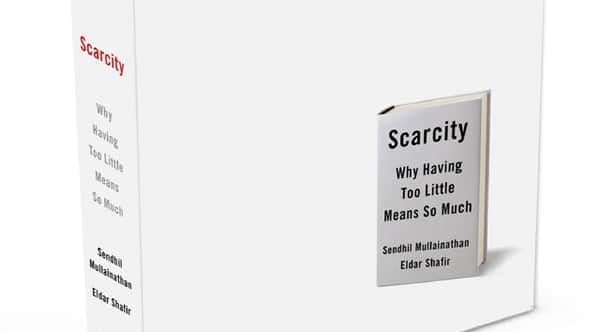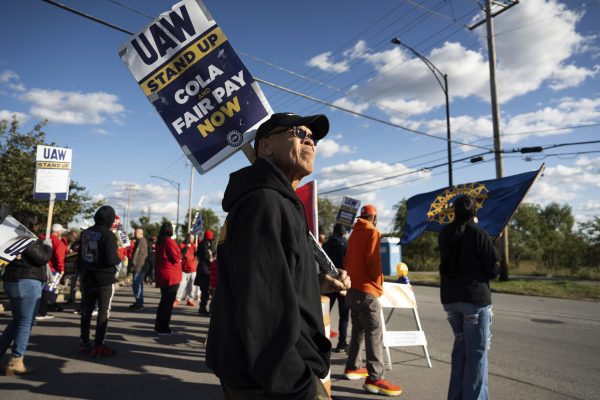Poor people don’t have enough money; busy people wish they had more time; dieting people constantly want for calories; lonely people lack companionship, etc. These very different settings of social behavior have in common the fact that the people in such situations acutely feel the lack of something that they value. In Scarcity: Why Having Too Little Means So Much (Times Books, 2013), Sendhil Mullainathan and Eldar Shafir offer a theory of “scarcity” which identifies common behavioral tendencies or orientations that individuals exhibit across these different situations. In no way do they claim that these behaviors or problems are otherwise similar, nor would they deny that there are factors at work in these diverse settings other than the psychological effects which they identify. But scarcity lays the foundation for thinking differently about poverty.
The book’s argument, supported by a wealth of experimental and observational data, is that a core scarcity is implicated in “not having enough.” A person’s cognitive capacities are limited. We can only attend to so many things, they say, and the condition of feeling a severe lack of something important to us influences how our minds allocate the limited cognitive resource that is our capacity to attend. We become obsessed; we tunnel in; we exhibit poor judgments, and these poor judgments can sometimes make our scarcity problem even worse.
This way of thinking has far-reaching implications for how we see the behavior of those subject to chronic scarcity—people who are mired in poverty. Thus, if we see in poor populations behaviors that differ systematically from behaviors observed among the better-off—kids doing poorly in school, and adults being less effective, less attentive parents, breaking the law more often, or maintaining less stable relationships—then, to the extent that the data bear out such generalizations, an important source of difference between the poor and everyone else is poverty itself. This overarching scarcity alters cognitive processes among poor folk and affects their decision-making in certain environments and at certain tasks in such a way that their capacity to function is fundamentally undermined. The poor, who may seem alien, are really just like the rest of us—except that what they lack is money.
This could lead to a really important alteration in the way we think about social policy. Don’t be so hard on the poor. Don’t yield to temptation and blame them for their self-limiting behaviors. Such actions by the poor are, at least in part, endogenous—the result of processes triggered by a scourge of “scarcity.” This, Mullainathan and Shafir suggest, is something we ought to take into account when formulating public policies that deal with the poor.
Another policy-related implication of the argument is that the benefits from relieving someone’s scarcity are not only to be observed at the point where the constraint binds. That is, if I give more calories or more money to a family, the beneficial effects won’t be limited only to achieving (say) better health outcomes. There could be a multiplier effect from relieving a scarcity constraint because doing so also increases cognitive capacity—or as Mullainathan and Shafir put it, enhances recipients’ “bandwidth,” so that the persons previously constrained in one area can now make more effective decisions in other areas of their lives.
A further observation prompted by reading this book has to do with the potential merits of paternalism. If some situations of severe scarcity leave people cognitively impaired then they may end-up taking decisions that might not, on reflection and from their own considered point of view, be in their interest. If so, then perhaps under their condition of severe scarcity they oughtn’t to be given a discretion that they are unable effectively to exercise? Perhaps we ought to make some decisions for them? In-kind transfers may be better in some settings than giving people cash. Mullainathan and Shafir don’t talk much about policy, but this “nudging big brother” is the specter of paternalism that haunts their argument.
Another thought which occurred to me while reading this book is this: If the ill-effects of scarcity are largely a matter of how we think, then can we talk people out of it? That is, can one envision a therapeutic practice that disabuses people of the distorted cognitive practices that they might otherwise lapse into? Consider the scarcity of time. So I’m overcommitted and I’m sweating it, rather than taking one day at a time and making sure every twenty-four hours is spent productively. The idea that I could simply be coached in time management may seem silly—or worse—if we speak of people not having enough money. But, it does not seem quite so callow to talk in this way about harried type-A personalities.
I was also stimulated to ponder scarcity’s implications for the regulation of political communication, specifically the design of campaigns. Candidates campaigning for office use advertising to appeal around election time for people to act a certain way in the voting booth. The art of persuasion here, as in other advertising arenas, is to quickly grab voters’ attention, to move them, so as to influence their behavior viscerally—rather than to deal with the things that are of deep significance to the country. It is much easier to get people’s juices flowing, so as to cause them to vote this way or that, by telling them something emotive—about a social issue, for instance. Perhaps by characterizing the opponent in demon terms, I can better exploit the cognitive limitations in the electorate (due to time/budget limitations that inhibit the ways that voters attend to political speech). Moreover, perhaps this kind of manipulation is easier to pull-off if the election is taking place all on a fixed date, with no capacity for people to decide upon their voting pattern over an extended period of electioneering. If so, then the campaign communication framework would have a temporal structure to it which candidates and parties could exploit by back-loading the money for a ton of ads on the weekend before the election. I’m just thinking off the top of my head. I am not a political scientist. Nevertheless, it seems to me that there is a rich vein to mine here, in the light that this book has thrown on the behavioral implications of scarcity, in terms of our thinking about institutional design.
My conversation with the authors can be found on bloggingheads.tv.








